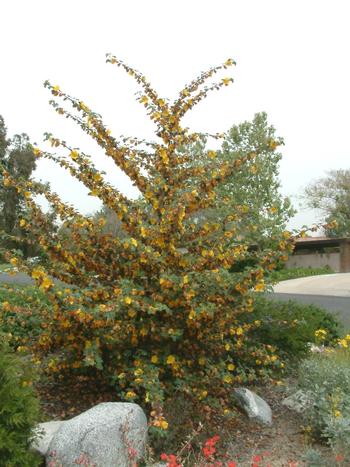Fremontodendron: the California native that glows in late spring and summer
-
Fremontia, one of the more spectacular California natives, grows quickly to a tall, slender shrub covered with 3-inch yellow blossoms in late spring through early summer. Evergreen, it is a show-stopper when in bloom, and a useful background shrub the rest of the year.
 Fremontodendron ‘California Glory’ is a showstopper in late spring and summer. Photo: Gardensoft
Fremontodendron ‘California Glory’ is a showstopper in late spring and summer. Photo: GardensoftWhile Fremontodendron californica is its proper botanic name, this plant is also known as flannelbush and is still referred to as fremontia, the name given to the quarterly journal of the California Native Plant Society. Incidentally, this plant is named for John C. Fremont, a celebrated 19th century California explorer, politician, and entrepreneur.
Fremontia is something of a relic among California’s native species. It is a survivor from a period 60 million years ago when California was less mountainous and more tropical. Two other survivors from this same period include fan palms and ironwood trees, still found in desert climates.
Although its natural habitat is on rocky slopes of open chaparral or woodland between 1,200 and 6,500 feet of the coast ranges and Sierra Nevada, fremontia does well in sunny, dry gardens in Marin.
Fast growing but typically short lived, fremontia seldom reaches its potential of 30 feet with 20 foot spread. It can be pruned successfully to keep it in scale with urban gardens. It is ideal when planted with other drought resistant California natives, particularly understory species like prostrate forms of ceanothus, coffeeberry, or western sword ferns. In a newer garden, where slow-growing natives take years to fill in, a few fremontia provide quick results (spectacular when blooming) and can be pruned, replaced or even removed later when other shrubs and trees have matured.
Several successful cultivars of fremontia are available and these promise even greater rewards to the gardener. ‘California Glory’ is one of the best and has bright yellow flowers, three-lobed dark green leaves, with initial upright growth, tending to arch with age to 20 feet. ‘El Dorado Gold,’ another hybrid, is lower growing from 4 to 6 feet, spreading to form a mound up to 12 feet, ideal as a sunny, drought tolerant ground cover. Other successful cultivars include ‘Pacific Sunset’ and ‘San Gabriel,’ both tall, and ‘Ken Taylor,’ which has showy, large orange-yellow blossoms, effective when used on a slope or retaining wall.
Fremontia has spreading, shallow roots so it’s advisable to stake young plants. Because it is susceptible to root rot, Judith Lowry recommends planting it on mounds or slopes mulched with as much as 8 inches of mulch. Good drainage and loose soil are critical. In Marin County, fremontia will likely thrive without any irrigation once it is established.
Leaves and the small, bristly seed capsules of fremontia are covered with tiny, skin-irritating brownish stellate hairs. After pruning fremontia, or working near it, the gardener is advised to shower and wash clothing. For this reason, one should not plant it adjacent to a patio or well-trod walkway. This disadvantage is overcome by the plant’s many advantages, another of which is that deer leave it alone, perhaps because of its irritating “fuzz.”
Original article by Julie Monson for the Marin IJ
Edited for the Leaflet by Marie Narlock

